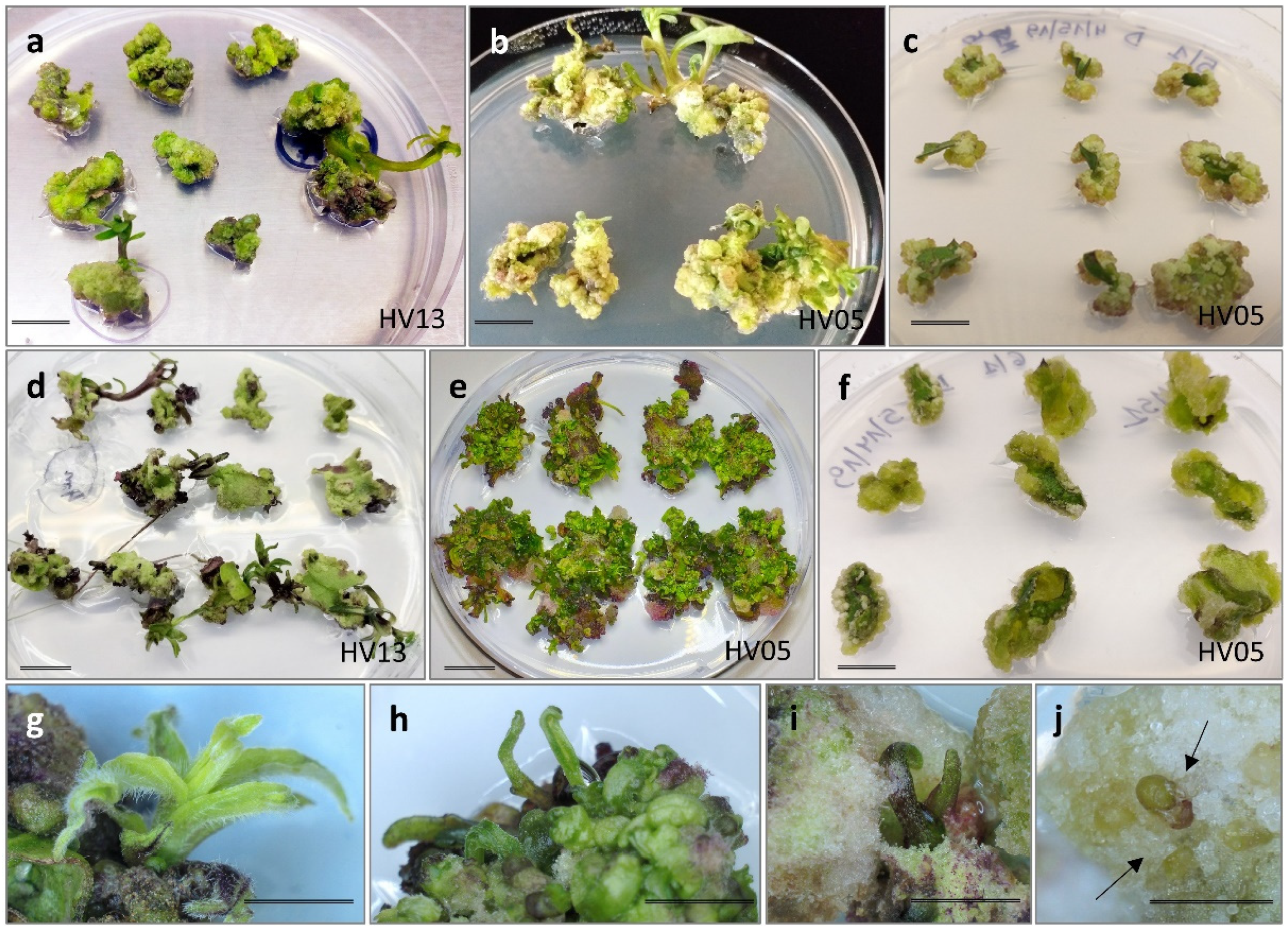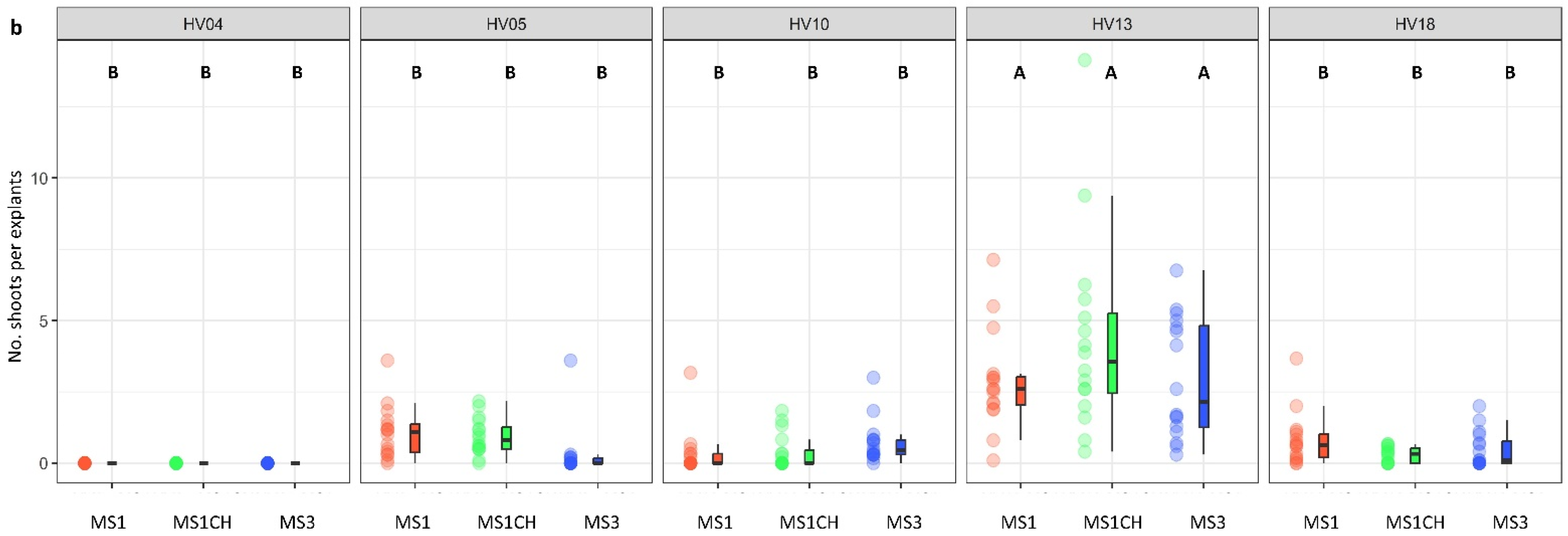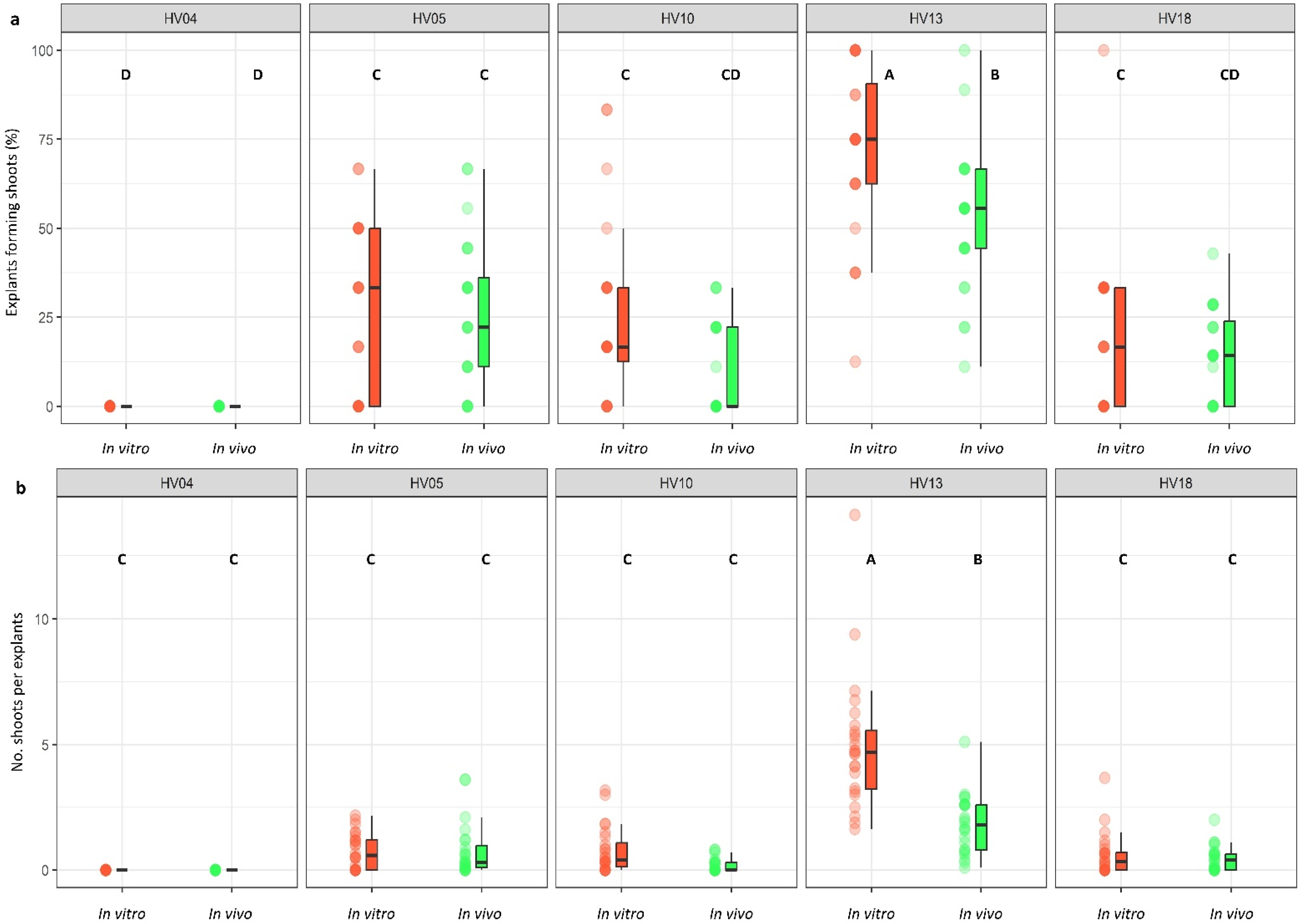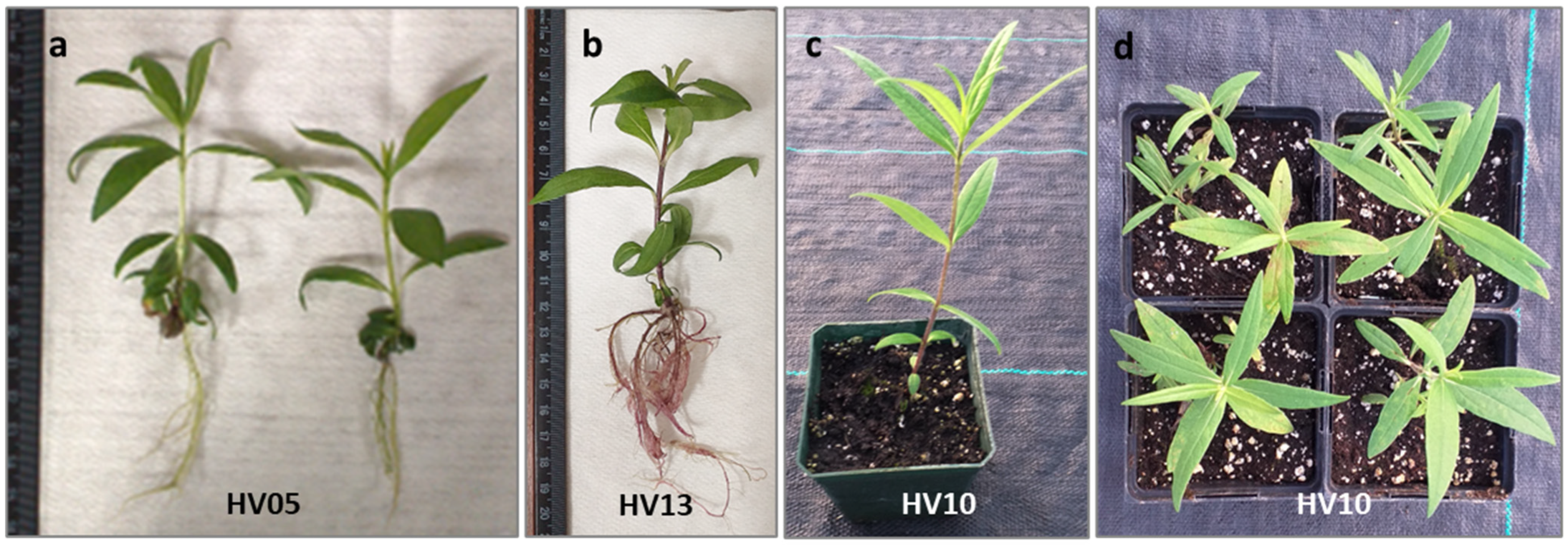In Vitro Regeneration from Leaf Explants of Helianthus verticillatus, a Critically Endangered Sunflower
Abstract
1. Introduction
2. Results and Discussion
2.1. Optimization of Induction Medium for Shoot Induction from Leaf Explants of Helianthus verticillatus
2.2. Effect of Genotype, Explant Source, and Medium on In Vitro Regeneration of H. verticillatus
2.3. Shoot Elongation and Multiplication
2.4. Rooting and Acclimatization
3. Materials and Methods
3.1. Plant Materials
3.2. Assessment of the Genetic Distance among the Donor Plants
3.3. Media and Culture Conditions
3.4. Experimental Design
3.4.1. Experiment 1: Optimization of Induction Medium for Regeneration
3.4.2. Experiment 2: Influence of Explant Source, Genotype, and Induction Medium on Shoot Regeneration
3.5. Shoot Elongation and Multiplication
3.6. Data Analysis
4. Conclusions
Supplementary Materials
Author Contributions
Funding
Data Availability Statement
Acknowledgments
Conflicts of Interest
References
- Bohra, A.; Kilian, B.; Sivasankar, S.; Caccamo, M.; Mba, C.; McCouch, S.R.; Varshney, R.K. Reap the crop wild relatives for breeding future crops. Trends Biotechnol. 2022, 40, 412–431. [Google Scholar] [CrossRef]
- Marek, L.F. Crop wild relatives of sunflower in North America. In North American Crop Wild Relatives, Volume 2: Important Species; Greene, S.L., Williams, K.A., Khoury, C.K., Kantar, M.B., Marek, L.F., Eds.; Springer International Publishing: Cham, Switzerland, 2019; pp. 453–483. [Google Scholar]
- Seiler, G.J.; Qi, L.L.; Marek, L.F. Utilization of sunflower crop wild relatives for cultivated sunflower improvement. Crop Sci. 2017, 57, 1083–1101. [Google Scholar] [CrossRef]
- U.S. Fish and Wildlife Service. Endangered and Threatened Wildlife and Plants; Designation of critical habitat for Physaria globosa (Short’s bladderpod), Helianthus verticillatus (whorled sunflower), and Leavenworthia crassa (fleshy-fruit gladecress); Final Rule; U.S. Fish and Wildlife Service: Washington, DC, USA, 2014; Volume 79, pp. 50990–51039.
- Moore, E.R.; Siniscalchi, C.M.; Mandel, J.R. Reevaluating genetic diversity and structure of Helianthus verticillatus (Asteraceae) after the discovery of new populations. Castanea 2022, 86, 196–213. [Google Scholar]
- Mandel, J.R. Clonal diversity, spatial dynamics, and small genetic population size in the rare sunflower, Helianthus verticillatus. Conserv. Genet. 2010, 11, 2055–2059. [Google Scholar] [CrossRef]
- Ellis, J.R.; McCauley, D.E. Phenotypic differentiation in fitness related traits between populations of an extremely rare sunflower: Conservation management of isolated populations. Biol. Conserv. 2009, 142, 1836–1843. [Google Scholar] [CrossRef]
- Trigiano, R.N.; Boggess, S.L.; Wyman, C.R.; Hadziabdic, D.; Wilson, S. Propagation methods for the conservation and preservation of the endangered whorled sunflower (Helianthus verticillatus). Plants 2021, 10, 1565. [Google Scholar] [CrossRef] [PubMed]
- Strange, N.C.; Moulton, J.K.; Bernard, E.C.; Klingeman, W.E.; Sampson, B.J.; Trigiano, R.N. Floral visitors to Helianthus verticillatus, a rare snflower species in the Southern United States. HortScience 2020, 55, 1980–1986. [Google Scholar] [CrossRef]
- Seiler, G.; Gulya, T.; Kong, G. Oil concentration and fatty acid profile of wild Helianthus species from the southeastern United States. Ind. Crop. Prod. 2010, 31, 527–533. [Google Scholar] [CrossRef]
- Sharma, S.; Thokchom, R. A review on endangered medicinal plants of India and their conservation. J. Crop Weed 2014, 10, 205–218. [Google Scholar]
- Banday, A.; Nawchoo, I.A.; Kaloo, Z.A.; Shabir, P.A.; Rather, A.A. Efficient propagation of an endangered medicinal plant Jurinea dolomiaea Boiss in the North Western Himalaya using rhizome cuttings under ex situ conditions. J. Plant Breed. Crop Sci. 2014, 6, 114–118. [Google Scholar] [CrossRef]
- Chauhan, H.K.; Bisht, A.K.; Bhatt, I.D.; Bhatt, A. Protocol for vegetative propagation of Trillium govanianum Wall ex D. Don. J. Appl. Res. Med. Aromat. Plants 2020, 16, 100233. [Google Scholar] [CrossRef]
- Butola, J.S.; Badola, H.K. Vegetative propagation of Angelica glauca and Heracleum candicans. J. Trop. Med. Plants 2007, 8, 85–91. [Google Scholar]
- Ahmad, N.; Anis, M. Rapid clonal multiplication of a woody tree, Vitex negundo L. through axillary shoots proliferation. Agrofor. Syst. 2007, 71, 195–200. [Google Scholar] [CrossRef]
- Oseni, O.M.; Pande, V.; Nailwal, T.K. A review on plant tissue culture, a technique for propagation and conservation of endangered plant species. Int. J. Curr. Microbiol. Appl. Sci. 2018, 7, 3778–3786. [Google Scholar] [CrossRef]
- Krishnan, P.N.; Decruse, S.W.; Radha, R.K. Conservation of medicinal plants of Western Ghats, India and its sustainable utilization through in vitro technology. Vitr. Cell. Dev. Biol. 2011, 47, 110–122. [Google Scholar] [CrossRef]
- Lavanya, A.; Muthukrishnan, S.; MuthuKumar, M.; Benjamin, J.F.; Kumar, T.S.; Kumaresan, V.; Rao, M. Indirect organogenesis from various explants of Hildegardia populifolia (Roxb.) Schott & Endl.—A threatened tree species from Eastern Ghats of Tamil Nadu, India. J. Genet. Eng. Biotechnol. 2014, 12, 95–101. [Google Scholar] [CrossRef]
- Savitikadi, P.; Jogam, P.; Rohela, G.K.; Ellendula, R.; Sandhya, D.; Allini, V.R.; Abbagani, S. Direct regeneration and genetic fidelity analysis of regenerated plants of Andrographis echioides (L.)—An important medicinal plant. Ind. Crop. Prod. 2020, 155, 112766. [Google Scholar] [CrossRef]
- Fay, M.F. Conservation of rare and endangered plants using in vitro methods. Vitr. Cell. Dev. Biol. Plant 1992, 28, 1–4. [Google Scholar] [CrossRef]
- Nowakowska, M.; Pavlović, Ž.; Nowicki, M.; Boggess, S.L.; Trigiano, R.N. In vitro propagation of an endangered Helianthus verticillatus by axillary bud proliferation. Plants 2020, 9, 712. [Google Scholar] [CrossRef]
- Wu, K.; Zeng, S.; Lin, D.; Teixeira da Silva, J.A.; Bu, Z.; Zhang, J.; Duan, J. In Vitro Propagation and Reintroduction of the Endangered Renanthera imschootiana Rolfe. PLoS ONE 2014, 9, e110033. [Google Scholar] [CrossRef]
- Malabadi, R.B.; Mulgund, G.S.; Nataraja, K. Efficient regeneration of Vanda coerulea, an endangered orchid using thidiazuron. Plant Cell Tissue Organ Cult. 2004, 76, 289–293. [Google Scholar] [CrossRef]
- Amghar, I.; Diria, G.; Boumlik, I.; Gaboun, F.; Iraqi, D.; Labhilili, M.; Mentag, R.; Meziani, R.; Mazri, M.A.; Ibriz, M.; et al. An efficient regeneration pathway through adventitious organogenesis for the endangered Argania spinosa (L.) Skeels. Vegetos 2021, 34, 355–367. [Google Scholar] [CrossRef]
- Faisal, M.; Ahmad, N.; Anis, M. An efficient micropropagation system for Tylophora indica: An endangered, medicinally important plant. Plant Biotechnol. Rep. 2007, 1, 155–161. [Google Scholar] [CrossRef]
- Riahi, L.; Chograni, H.; Ben Rejeb, F.; Ben Romdhane, M.; Masmoudi, A.S.; Cherif, A. Efficient in vitro regeneration of the endangered species Artemisia arborescens L. through direct organogenesis and impact on secondary metabolites production. Hortic. Environ. Biotechnol. 2022, 63, 439–450. [Google Scholar] [CrossRef]
- Yang, G.; Lü, J.; Teixeira da Silva, J.A.; Chen, H.; Ma, G. Shoot organogenesis from leaf explants of Dayaoshania cotinifolia W. T. Wang. Vitr. Cell. Dev. Biol. Plant 2014, 50, 451–457. [Google Scholar] [CrossRef]
- Deglene, L.; Lesignes, P.; Alibert, G.; Sarrafi, A. Genetic control of organogenesis in cotyledons of sunflower (Helianthus annuus). Plant Cell Tissue Organ Cult. 1997, 48, 127–130. [Google Scholar] [CrossRef]
- Paterson, K.E.; Everett, N.P. Regeneration of Helianthus annuus inbred plants from callus. Plant Sci. 1985, 42, 125–132. [Google Scholar] [CrossRef]
- Knittel, N.; Escandón, A.S.; Hahne, G. Plant regeneration at high frequency from mature sunflower cotyledons. Plant Sci. 1991, 73, 219–226. [Google Scholar] [CrossRef]
- Weber, S.; Horn, R.; Friedt, W. High regeneration potential in vitro of sunflower (Helianthus annuus L.) lines derived from interspecific hybridization. Euphytica 2000, 116, 271–280. [Google Scholar] [CrossRef]
- Espinasse, A.; Lay, C. Shoot regeneration of callus derived from globular to torpedo embryos from 59 sunflower genotypes. Crop Sci. 1989, 29, 201–205. [Google Scholar] [CrossRef]
- Hewezi, T.; Jardinaud, F.; Alibert, G.; Kallerhoff, J. A new approach for efficient regeneration of a recalcitrant genotype of sunflower (Helianthus annuus) by organogenesis induction on split embryonic axes. Plant Cell Tissue Organ Cult. 2003, 73, 81–86. [Google Scholar] [CrossRef]
- Lupi, M.C.; Bennici, A.; Locci, F.; Gennai, D. Plantlet formation from callus and shoot-tip culture of Helianthus annuus (L.). Plant Cell Tissue Organ Cult. 1987, 11, 47–55. [Google Scholar] [CrossRef]
- Prado, E.; Berville, A. Induction of somatic embryo development by liquid culture in sunflower (Helianthus annuus L.). Plant Sci. 1990, 67, 73–82. [Google Scholar] [CrossRef]
- Inoka, K.; Dahanayake, N. Effect of plant growth regulators on micro-propagation of sunflower (Helianthus annuus L.). Int. J. Sci. Res. 2015, 5, 1–5. [Google Scholar]
- Jeannin, G.; Bronner, R.; Hahne, G. Somatic embryogenesis and organogenesis induced on the immature zygotic embryo of sunflower (Helianthus annum L.) cultivated in vitro: Role of the sugar. Plant Cell Rep. 1995, 15, 200–204. [Google Scholar] [CrossRef] [PubMed]
- Fiore, M.C.; Trabace, T.; Sunseri, F. High frequency of plant regeneration in sunflower from cotyledons via somatic embryogenesis. Plant Cell Rep. 1997, 16, 295–298. [Google Scholar] [CrossRef] [PubMed]
- Charrière, F.; Sotta, B.; Miginiac, É.; Hahne, G. Induction of adventitious shoots or somatic embryos on in vitro cultured zygotic embryos of Helianthus annuus: Variation of endogenous hormone levels. Plant Physiol. Biochem. 1999, 37, 751–757. [Google Scholar] [CrossRef]
- Kim, M.-J.; An, D.-J.; Moon, K.-B.; Cho, H.-S.; Min, S.-R.; Sohn, J.-H.; Jeon, J.-H.; Kim, H.-S. Highly efficient plant regeneration and Agrobacterium-mediated transformation of Helianthus tuberosus L. Ind. Crop. Prod. 2016, 83, 670–679. [Google Scholar] [CrossRef]
- Berrios, E.; Gentzbittel, L.; Alibert, G.; Griveau, Y.; Bervillé, A.; Sarraf, A. Genetic control of in vitro-organogenesis in recombinant inbred lines of sunflower (Helianthus annuus L.). Plant Breed. 1999, 118, 359–361. [Google Scholar] [CrossRef]
- Fambrini, M.; Cionini, G.; Pugliesi, C. Development of somatic embryos from morphogenetic cells of the interspecific hybrid Helianthus annuus × Helianthus tuberosus. Plant Sci. 1996, 114, 205–214. [Google Scholar] [CrossRef]
- Pugliesi, C.; Megale, P.; Cecconi, F.; Baroncelli, S. Organogenesis and embryogenesis in Helianthus tuberosus and in the interspecific hybrid Helianthus annuus × Helianthus tuberosus. Plant Cell Tissue Organ Cult. 1993, 33, 187–193. [Google Scholar] [CrossRef]
- Bohorova, N.; Atanassov, A.; Georgieva-Todorova, J. In vitro organogenesis, androgenesis and embryo-culture in the genus Helianthus. Z. Pflanzenzüchtg. 1985, 95, 35–44. [Google Scholar]
- Krasnyanski, S.; Polgár, Z.; Németh, G.; Menczel, L. Plant regeneration from callus and protoplast cultures of Helianthus giganteus L. Plant Cell Rep. 1992, 11, 7–10. [Google Scholar] [CrossRef] [PubMed]
- Polgár, Z.; Krasnyanski, S. Plant regeneration from cell suspension and mesophyll protoplasts of Helianthus maximiliani (Schrad.). Plant Sci. 1992, 87, 191–197. [Google Scholar] [CrossRef]
- Punia, M.S.; Bohorova, N.E. Callus development and plant regeneration from different explants of six wild species of sunflower (Helianthus L.). Plant Sci. 1992, 87, 79–83. [Google Scholar] [CrossRef]
- Vasic, D.; Alibert, G.; Skoric, D. Protocols for efficient repetitive and secondary somatic embryogenesis in Helianthus maximiliani (Schrader). Plant Cell Rep. 2001, 20, 121–125. [Google Scholar] [CrossRef]
- Yordanov, Y.; Yordanova, E.; Atanassov, A. Plant regeneration from interspecific hybrid and backcross progeny of Helianthus eggertii × Helianthus annuus. Plant Cell Tissue Organ Cult. 2002, 71, 7–14. [Google Scholar] [CrossRef]
- Laparra, H.; Stoeva, P.; Ivanov, P.; Hahne, G. Plant regeneration from different explants in Helianthus smithii Heiser. Plant Cell Rep. 1997, 16, 692–695. [Google Scholar] [CrossRef]
- Sarrafi, A.; Bolandi, A.R.; Serieys, H.; Bervillé, A.; Alibert, G. Analysis of cotyledon culture to measure genetic variability for organogenesis parameters in sunflower (Helianthus annuus L.). Plant Sci. 1996, 121, 213–219. [Google Scholar] [CrossRef]
- Witrzens, B.; Scowcroft, W.R.; Downes, R.W.; Larkin, P.J. Tissue culture and plant regeneration from sunflower (Helianthus annuus) and interspecific hybrids (H. tuberosus × H. annuus). Plant Cell Tissue Organ Cult. 1988, 13, 61–76. [Google Scholar] [CrossRef]
- Abdoli, M.; Moieni, A.; Dehghani, H. Effects of cultivar and agar concentration on in vitro shoot organogenesis and hyperhydricity in sunflower (Helianthus annuus L.). Pak. J. Bot. 2007, 39, 31. [Google Scholar]
- Heesacker, A.; Kishore, V.K.; Gao, W.; Tang, S.; Kolkman, J.M.; Gingle, A.; Matvienko, M.; Kozik, A.; Michelmore, R.M.; Lai, Z. SSRs and INDELs mined from the sunflower EST database: Abundance, polymorphisms, and cross-taxa utility. Theor. Appl. Genet. 2008, 117, 1021–1029. [Google Scholar] [CrossRef] [PubMed]
- Bidabadi, S.S.; Jain, S.M. Cellular, molecular, and physiological aspects of in vitro plant regeneration. Plants 2020, 9, 702. [Google Scholar] [CrossRef]
- Li, Q.; Chen, R.; Chen, X.; Yang, Y.; Wu, H. Estimation of the cloning potential in six selected genotypes of purple coneflower (Echinacea purpurea L.). Biotechnol. Biotechnol. Equip. 2013, 27, 3911–3917. [Google Scholar] [CrossRef]
- Naing, A.H.; Jeon, S.M.; Han, J.-S.; Lim, S.H.; Lim, K.B.; Kim, C.K. Factors influencing in vitro shoot regeneration from leaf segments of Chrysanthemum. Comptes Rendus Biol. 2014, 337, 383–390. [Google Scholar] [CrossRef]
- Feyissa, T.; Welander, M.; Negash, L. Micropropagation of Hagenia abyssinica: A multipurpose tree. Plant Cell Tissue Organ Cult. 2005, 80, 119–127. [Google Scholar] [CrossRef]
- Pellegrineschi, A. In vitro plant regeneration via organogenesis of cowpea [Vigna unguiculata (L.) Walp.]. Plant Cell Rep. 1997, 17, 89–95. [Google Scholar] [CrossRef]
- Hou, J.; Su, P.; Wang, D.; Chen, X.; Zhao, W.; Wu, L. Efficient plant regeneration from in vitro leaves and petioles via shoot organogenesis in Sapium sebiferum Roxb. Plant Cell Tissue Organ Cult. 2020, 142, 143–156. [Google Scholar] [CrossRef]
- Kumar, N.; Vijay Anand, K.G.; Reddy, M.P. Plant regeneration of non-toxic Jatropha curcas—Impacts of plant growth regulators, source and type of explants. J. Plant Biochem. Biotechnol. 2011, 20, 125–133. [Google Scholar] [CrossRef]
- Sharma, S.; Kumar, N.; Reddy, M.P. Regeneration in Jatropha curcas: Factors affecting the efficiency of in vitro regeneration. Ind. Crop. Prod. 2011, 34, 943–951. [Google Scholar] [CrossRef]
- Ozaslan, M.; Can, C.; Aytekin, T. Effect of explant source on in vitro propagation of Paulownia tomentosa Steud. Biotechnol. Biotechnol. Equip. 2005, 19, 20–26. [Google Scholar] [CrossRef]
- Giusti, P.; Vitti, D.; Fiocchetti, F.; Colla, G.; Saccardo, F.; Tucci, M. In vitro propagation of three endangered cactus species. Sci. Hortic. 2002, 95, 319–332. [Google Scholar] [CrossRef]
- Koroch, A.; Juliani, H.; Kapteyn, J.; Simon, J. In vitro regeneration of Echinacea purpurea from leaf explants. Plant Cell Tissue Organ Cult. 2002, 69, 79–83. [Google Scholar] [CrossRef]
- Echeverrigaray, S.; Fracaro, F.; Andrade, L.; Biasio, S.; Atti-Serafini, L. In vitro shoot regeneration from leaf explants of Roman Chamomile. Plant Cell Tissue Organ Cult. 2000, 60, 1–4. [Google Scholar] [CrossRef]
- Gurel, E.; Yucesan, B.; Aglic, E.; Gurel, S.; Verma, S.K.; Sokmen, M.; Sokmen, A. Regeneration and cardiotonic glycoside production in Digitalis davisiana Heywood (Alanya Foxglove). Plant Cell Tissue Organ Cult. 2011, 104, 217–225. [Google Scholar] [CrossRef]
- Ramírez-Mosqueda, M.A.; Iglesias-Andreu, L.G. Indirect organogenesis and assessment of somaclonal variation in plantlets of Vanilla planifolia Jacks. Plant Cell Tissue Organ Cult. 2015, 123, 657–664. [Google Scholar] [CrossRef]
- Galán-Ávila, A.; García-Fortea, E.; Prohens, J.; Herraiz, F.J. Development of a direct in vitro plant regeneration protocol from Cannabis sativa L. seedling explants: Developmental morphology of shoot regeneration and ploidy level of regenerated plants. Front. Plant Sci. 2020, 11, 645. [Google Scholar] [CrossRef]
- Grieneisen, V.A.; Xu, J.; Marée, A.F.; Hogeweg, P.; Scheres, B. Auxin transport is sufficient to generate a maximum and gradient guiding root growth. Nature 2007, 449, 1008–1013. [Google Scholar] [CrossRef]
- Pashley, C.H.; Ellis, J.R.; McCauley, D.E.; Burke, J.M. EST Databases as a Source for Molecular Markers: Lessons from Helianthus. J. Hered. 2006, 97, 381–388. [Google Scholar] [CrossRef]
- Edwards, T.P.; Trigiano, R.N.; Ownley, B.H.; Windham, A.S.; Wyman, C.R.; Wadl, P.A.; Hadziabdic, D. Genetic diversity and conservation status of Helianthus verticillatus, an endangered sunflower of the Southern United States. Front. Genet. 2020, 11, 410. [Google Scholar] [CrossRef]
- Wang, X.; Rinehart, T.A.; Wadl, P.A.; Spiers, J.M.; Hadziabdic, D.; Windham, M.T.; Trigiano, R.N. A new electrophoresis technique to separate microsatellite alleles. Afr. J. Biotechnol. 2009, 8, 2432–2436. [Google Scholar]
- Amos, W.; Hoffman, J.; Frodsham, A.; Zhang, L.; Best, S.; Hill, A. Automated binning of microsatellite alleles: Problems and solutions. Mol. Ecol. Notes 2007, 7, 10–14. [Google Scholar] [CrossRef]
- Kamvar, Z.N.; Tabima, J.F.; Grünwald, N. Poppr: An R package for genetic analysis of populations with clonal, partially clonal, and/or sexual reproduction. PeerJ 2014, 2, e281. [Google Scholar] [CrossRef]
- Bruvo, R.; Michiels, N.K.; D’Souza, T.G.; Schulenburg, H. A simple method for the calculation of microsatellite genotype distances irrespective of ploidy level. Mol. Ecol. 2004, 13, 2101–2106. [Google Scholar] [CrossRef]
- Murashige, T.; Skoog, F. A revised medium for rapid growth and bio assays with tobacco tissue cultures. Physiol. Plant. 1962, 15, 473–497. [Google Scholar] [CrossRef]
- Fox, J.; Weisberg, S. An R Companion to Applied Regression, 3rd ed.; Sage: Thousand Oaks, CA, USA, 2019; Available online: https://socialsciences.mcmaster.ca/jfox/Books/Companion (accessed on 10 November 2020).





| Induction Medium | PGRs (μM) | Genotype | Explants Forming Callus (%) | Explants Forming Shoots (%) | No. of Shoots/Explant |
|---|---|---|---|---|---|
| MS0 | - | HV04 | 0 c | 0 d | 0 c |
| HV05 | 0 c | 0 d | 0 c | ||
| HV10 | 0 c | 0 d | 0 c | ||
| MS1 | BA (8.88) NAA (1.08) | HV04 | 100 a | 0 d | 0 c |
| HV05 | 100 a | 50.0 ± 14.4 a | 1.43 ± 0.78 a | ||
| HV10 | 100 a | 5.6 ± 11.1 d | 0.20 ± 0.4 bc | ||
| MS1CH | BA (8.88) NAA (1.08) CH (500 mg × L−1) | HV04 | 100 a | 0 d | 0 c |
| HV05 | 97.2 ± 5.6 a | 22.2 ± 9.1 bc | 0.43 ± 0.26 bc | ||
| HV10 | 100 a | 5.6 ± 6.4 d | 0.08 ± 0.09 bc | ||
| MS2 | BA (4.44) NAA (0.54) | HV04 | 100 a | 0 d | 0 c |
| HV05 | 100 a | 11.1 ± 9.1 cd | 0.23 ± 0.26 bc | ||
| HV10 | 100 a | 7.2 ± 14.3 d | 0.08 ± 0.15 bc | ||
| MS3 | BA (2.20) NAA (2.68) | HV04 | 100 a | 0 d | 0 c |
| HV05 | 100 a | 33.3 ± 9.1 b | 0.63 ± 0.47 b | ||
| HV10 | 100 a | 25.0 ± 5.6 bc | 0.45 ± 0.23 bc | ||
| MS4 | BA (2.20) NAA (0.27) | HV04 | 100 a | 0 d | 0 c |
| HV05 | 100 a | 0 d | 0 c | ||
| HV10 | 100 a | 0 d | 0 c | ||
| MS5 | ZEARIB (2.82) | HV04 | 100 a | 0 d | 0 c |
| HV05 | 100 a | 0 d | 0 c | ||
| HV10 | 96.4 ± 7.2 a | 0 d | 0 c | ||
| MS6 | BA (2.22) | HV04 | 0 c | 0 d | 0 c |
| HV05 | 0 c | 0 d | 0 c | ||
| HV10 | 0 c | 0 d | 0 c | ||
| MS7 | BA (4.44) | HV04 | 5.6 ± 11.1 c | 0 d | 0 c |
| HV05 | 22.2 ± 18.1 b | 0 d | 0 c | ||
| HV10 | 0 c | 0 d | 0 c | ||
| MS8 | BA (8.88) | HV04 | 0 c | 0 d | 0 c |
| HV05 | 0 c | 0 d | 0 c | ||
| HV10 | 0 c | 0 d | 0 c |
| Tested Parameters | Variation Source | Sum of Squares | F Value | p Value [Pr (>F)] |
|---|---|---|---|---|
| Explants forming calli (%) | Genotype (A) | 63.3 | 1.2 | 3.14 × 10−1 ns |
| Explant Source (B) | 93.8 | 7.1 | 8.00 × 10−3 ** | |
| Induction Medium (C) | 39.1 | 1.5 | 2.31 × 10−1 ns | |
| A × B | 30.1 | 0.6 | 6.86 × 10−1 ns | |
| A × C | 43.6 | 0.4 | 9.13 × 10−1 ns | |
| B × C | 76.2 | 2.9 | 5.80 × 10−2 ns | |
| A × B × C | 86.1 | 0.8 | 5.92 × 10−1 ns | |
| Explants forming shoots (%) | Genotype (A) | 100,694.0 | 88.1 | <2.20 × 10−16 *** |
| Explant Source (B) | 4358.0 | 15.3 | 1.27 × 10−4 *** | |
| Induction Medium (C) | 941.0 | 1.6 | 1.95 × 10−1 ns | |
| A × B | 3624.0 | 3.2 | 1.48 × 10−2 * | |
| A × C | 12,242.0 | 5.4 | 3.90 × 10−6 *** | |
| B × C | 1989.0 | 3.5 | 3.26 × 10−2 * | |
| A × B × C | 2390.0 | 1.1 | 4.03 × 10−1 ns | |
| Number of shoots per explants | Genotype (A) | 348.7 | 82.3 | <2.20 × 10−16 *** |
| Explant Source (B) | 36.9 | 34.8 | 1.43 × 10−8 *** | |
| Induction Medium (C) | 3.7 | 1.8 | 1.75 × 10−1 ns | |
| A × B | 85.1 | 20.1 | 5.09 × 10−14 *** | |
| A × C | 27.2 | 3.2 | 1.85 × 10−3 ** | |
| B × C | 2.9 | 1.4 | 2.60 × 10−1 ns | |
| A × B × C | 14.7 | 1.7 | 9.22 × 10−2 ns |
| Explant Source | Induction Medium * | Rooting Percentage | |||
|---|---|---|---|---|---|
| Genotype | |||||
| HV05 | HV10 | HV13 | HV18 | ||
| In vivo | MS1 | 100.0 | 100.0 | 98.6 | 100.0 |
| MS1CH | 100.0 | 100.0 | 98.8 | 100.0 | |
| MS3 | 100.0 | 100.0 | 89.8 | 100.0 | |
| In vitro | MS1 | 100.0 | 100.0 | 87.5 | 100.0 |
| MS1CH | 89.3 | 100.0 | 88.6 | 100.0 | |
| MS3 | 100.0 | 100.0 | 87.7 | 100.0 | |
Disclaimer/Publisher’s Note: The statements, opinions and data contained in all publications are solely those of the individual author(s) and contributor(s) and not of MDPI and/or the editor(s). MDPI and/or the editor(s) disclaim responsibility for any injury to people or property resulting from any ideas, methods, instructions or products referred to in the content. |
© 2024 by the authors. Licensee MDPI, Basel, Switzerland. This article is an open access article distributed under the terms and conditions of the Creative Commons Attribution (CC BY) license (https://creativecommons.org/licenses/by/4.0/).
Share and Cite
Nowakowska, M.; Pavlovic, Z.; Nowicki, M.; Boggess, S.L.; Trigiano, R.N. In Vitro Regeneration from Leaf Explants of Helianthus verticillatus, a Critically Endangered Sunflower. Plants 2024, 13, 285. https://doi.org/10.3390/plants13020285
Nowakowska M, Pavlovic Z, Nowicki M, Boggess SL, Trigiano RN. In Vitro Regeneration from Leaf Explants of Helianthus verticillatus, a Critically Endangered Sunflower. Plants. 2024; 13(2):285. https://doi.org/10.3390/plants13020285
Chicago/Turabian StyleNowakowska, Marzena, Zaklina Pavlovic, Marcin Nowicki, Sarah L. Boggess, and Robert N. Trigiano. 2024. "In Vitro Regeneration from Leaf Explants of Helianthus verticillatus, a Critically Endangered Sunflower" Plants 13, no. 2: 285. https://doi.org/10.3390/plants13020285
APA StyleNowakowska, M., Pavlovic, Z., Nowicki, M., Boggess, S. L., & Trigiano, R. N. (2024). In Vitro Regeneration from Leaf Explants of Helianthus verticillatus, a Critically Endangered Sunflower. Plants, 13(2), 285. https://doi.org/10.3390/plants13020285






